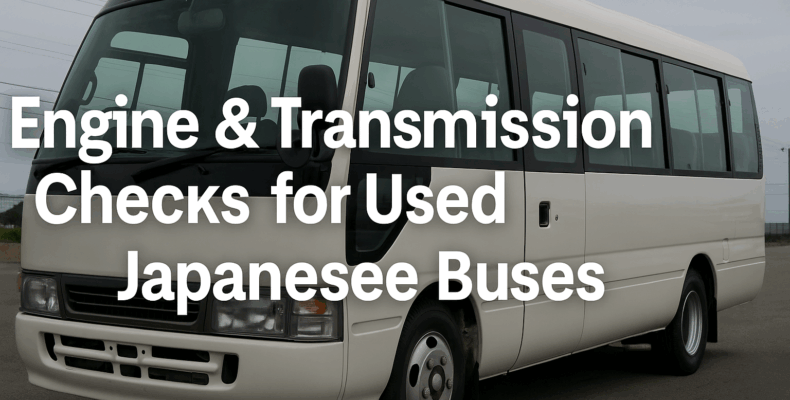When purchasing a used Japanese bus for export, the engine and transmission condition plays a key role. Buyers worldwide—especially from countries like Kenya, the Philippines, and the UAE—prefer Japanese buses for their reliability. However, skipping an inspection can lead to unexpected repairs.
In this post, we’ll show you how to evaluate these two crucial systems effectively. Whether you’re a seasoned importer or a first-time buyer, these tips will help you make a safe and profitable choice.
1. Why Engine Health Is Your Top Priority
Firstly, always start with the engine. It is the heart of any bus, and signs of wear are often easy to spot.
-
Listen for irregular noises. Knocking, rattling, or hissing could signal internal problems.
-
Check the exhaust smoke. Excessive black, blue, or white smoke is usually a red flag.
-
Review the engine start-up. A healthy engine should start smoothly, even when cold.
-
Inspect for oil leaks. Oil around the valve cover or near the oil pan indicates sealing issues.
Additionally, reviewing the bus’s maintenance records can confirm whether the timing belt, injectors, and filters have been replaced at regular intervals.
👉 See why records matter here:
🔗 Top 5 Trusted Japanese Used Truck Exporters for Global Buyers
2. Transmission Tests You Should Never Skip
Secondly, the transmission should be tested in both idle and drive modes.
-
Automatic transmissions must shift smoothly. Any delay or hard shifting can point to internal damage.
-
Manual transmissions should engage all gears easily. Grinding sounds are a serious warning.
-
Clutch condition is critical. A worn clutch will cause slippage or difficulty in gear engagement.
-
Transmission fluid should be clean and reddish. Brown fluid or a burnt smell means it’s time for service or replacement.
In either case, test the bus under load—especially uphill if possible. This reveals how the transmission handles torque and shifting under stress.
3. Ask for a Professional Inspection Report
While photos and videos are useful, nothing replaces a mechanical inspection report. Many Japanese exporters offer this at no extra cost. The report should include:
-
Engine compression test results
-
Transmission functionality
-
Oil condition
-
Cooling system performance
-
Emission test ratings
If the exporter cannot provide these, consider it a red flag.
4. Fuel Efficiency and Power Balance
Used buses with well-maintained engines often deliver excellent fuel efficiency. In contrast, misfires or power imbalance between cylinders increase fuel use. A test drive will help you identify this.
Also, turbocharged diesel engines require special care. So, ensure that turbo lag or power surges are not present. Look for oil around the turbo housing—it can indicate wear or leaks.
5. Trust Only Verified Exporters
Ultimately, no inspection tip beats a reliable exporter. Verified sellers in Japan offer not only quality vehicles but also transparency.
They provide:
-
Service history
-
Third-party inspection
-
Pre-shipping engine checks
-
Clear mechanical grading systems
👉 See our list of top-rated companies here:
🔗 Top 5 Trusted Japanese Used Truck Exporters for Global Buyers
Final Thoughts
Buying a used Japanese bus is a smart investment—if you inspect the engine and transmission properly. Use these tips as your checklist and never skip professional evaluations. Combined with a trusted exporter, you’ll reduce risk and boost long-term value.
Japanese buses are built to last, but smart buying ensures they perform well in your country.
